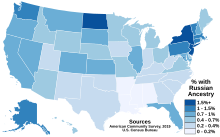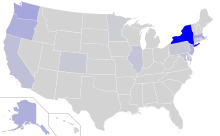
Back Inmigración rusa en los Estados Unidos Spanish آمریکاییهای روستبار Persian Amerikanvenäläiset Finnish Russo-Américains French Rusia Amerika ID Russo-americani Italian ロシア系アメリカ人 Japanese 러시아계 미국인 Korean Amerykanie pochodzenia rosyjskiego Polish Русские американцы Russian
Русские американцы | |
|---|---|
 | |
| Total population | |
| 2,432,733 self-reported[1] 0.741% of the U.S. population (2019) 391,641 Russian-born[2] | |
| Regions with significant populations | |
| |
| Languages | |
| English, Russian | |
| Religion | |
| Predominantly: Eastern Orthodoxy (Russian Orthodox Church, Orthodox Church in America) Minority: Old Believers (Russian Orthodox Old-Rite Church), Catholic Church, Protestantism, Judaism, Shamanism, Tengrism | |
| Related ethnic groups | |
| Belarusian Americans, Rusyn Americans, Ukrainian Americans, Russian Jews, Alaskan Creoles |

Russian Americans (Russian: русские американцы, tr. russkiye amerikantsy, IPA: [ˈruskʲɪje ɐmʲɪrʲɪˈkant͡sɨ]) are Americans of full or partial Russian ancestry. The term can apply to recent Russian immigrants to the United States, as well as to those who settled in the 19th century Russian possessions in northwestern America. Russian Americans comprise the largest Eastern European and East Slavic population in the U.S., the second-largest Slavic population generally, the nineteenth-largest ancestry group overall, and the eleventh-largest from Europe.[3]
In the mid-19th century, waves of Russian immigrants fleeing religious persecution settled in the U.S., including Russian Jews and Spiritual Christians. From 1880 to 1917, within the wave of European immigration to the U.S. that occurred during that period, a large number of Russians immigrated primarily for economic opportunities. These groups mainly settled in coastal cities, including Brooklyn (New York City) on the East Coast, and Los Angeles, San Francisco, Portland, Oregon, and various cities in Alaska, on the West Coast, as well as in Great Lakes cities, such as Chicago and Cleveland. After the Russian Revolution of 1917 and the Russian Civil War of 1917–1922, many White émigrés also arrived, especially in New York, Philadelphia, and New England. Emigration from Russia subsequently became very restricted during the Soviet era (1917–1991). However, after the dissolution of the Soviet Union at the end of the Cold War, immigration to the United States increased considerably.
In several major U.S. cities, many Jewish Americans who trace their heritage back to Russia and other Americans of East Slavic origin, such as Belarusian Americans and Rusyn Americans, sometimes identify as Russian Americans. Additionally, certain non-Slavic groups from the post-Soviet space, such as Armenian Americans, Georgian Americans, and Moldovan Americans, have a longstanding historical association with the Russian American community.
- ^ "Table B04006 - PEOPLE REPORTING ANCESTRY - 2019 American Community Survey 1-Year Estimates". United States Census Bureau. Retrieved March 14, 2021.
- ^ "Table B05006 - PLACE OF BIRTH FOR THE FOREIGN-BORN POPULATION IN THE UNITED STATES - 2019 American Community Survey 5-Year Estimates". United States Census Bureau. Retrieved February 7, 2021.
- ^ "Largest Ethnic Groups and Nationalities in US". World Atlas. July 18, 2019. Retrieved July 18, 2019.
© MMXXIII Rich X Search. We shall prevail. All rights reserved. Rich X Search